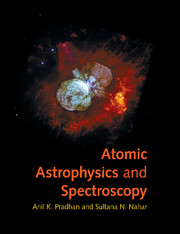Book contents
- Frontmatter
- Contents
- Preface
- Acknowledgements
- 1 Introduction
- 2 Atomic structure
- 3 Atomic processes
- 4 Radiative transitions
- 5 Electron–ion collisions
- 6 Photoionization
- 7 Electron–ion recombination
- 8 Multi-wavelength emission spectra
- 9 Absorption lines and radiative transfer
- 10 Stellar properties and spectra
- 11 Opacity and radiative forces
- 12 Gaseous nebulae and H II regions
- 13 Active galactic nuclei and quasars
- 14 Cosmology
- Appendix A Periodic table
- Appendix B Physical constants
- Appendix C Angular algebra and generalized radiative transitions
- Appendix D Coefficients of the fine structure components of an LS multiplet
- Appendix E Effective collision strengths and A-values
- References
- Index
14 - Cosmology
Published online by Cambridge University Press: 05 June 2012
- Frontmatter
- Contents
- Preface
- Acknowledgements
- 1 Introduction
- 2 Atomic structure
- 3 Atomic processes
- 4 Radiative transitions
- 5 Electron–ion collisions
- 6 Photoionization
- 7 Electron–ion recombination
- 8 Multi-wavelength emission spectra
- 9 Absorption lines and radiative transfer
- 10 Stellar properties and spectra
- 11 Opacity and radiative forces
- 12 Gaseous nebulae and H II regions
- 13 Active galactic nuclei and quasars
- 14 Cosmology
- Appendix A Periodic table
- Appendix B Physical constants
- Appendix C Angular algebra and generalized radiative transitions
- Appendix D Coefficients of the fine structure components of an LS multiplet
- Appendix E Effective collision strengths and A-values
- References
- Index
Summary
Which atoms were formed first, in what proportion and when? The relationship between atomic spectroscopy and cosmology rests on the answer to these questions. According to big bang nucleosynthesis (BBN), before the creation of the first atoms, the Universe would have been filled with a highly dense ensemble of nuclei, free electrons, and radiation. The standard model from high-energy particle physics implies that most observable matter is made of baryons, such as protons and neutrons; electrons are leptons and much less massive. The baryons are themselves made of more exotic fundamental particles, such as quarks, gluons and so forth. According to the BBN theory, given a fixed baryon-to-photon ratio in the first three minutes of origin, a few primordial nuclear species made of baryons appeared. The atomic nuclei created during the BBN were predominantly protons and helium nuclei (2He3, 2He4), with very small trace amounts of deuterium (heavy hydrogen 2H1) and lithium (3Li6, 3Li7). Atomic physics then determines that singly ionized helium He II (not hydrogen!) would have been the first atoms(ions) formed.
The process of formation is (e + ion) recombination: He III + e → He II + hν. This temporal marker in the history of the Universe is referred to as the recombination epoch. The reason that He II was the first atomic species is not difficult to see, given the extremely hot plasma that preceded the recombination epoch when nuclei and electrons were free in the fully ionized state.
- Type
- Chapter
- Information
- Atomic Astrophysics and Spectroscopy , pp. 305 - 323Publisher: Cambridge University PressPrint publication year: 2011



